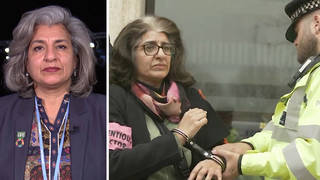
By Amy Goodman and Denis Moynihan
PARIS—The candles still burn across this city at the massacre memorials to the more than 130 people killed by armed militants identified with the Islamic State (which, many Muslims point out, is neither Islamic nor a state), from the Bataclan theater to the restaurants attacked nearby and the national stadium. Flowers, messages, French flags, photos and mementos of the dead, reproductions of the now-iconic peace sign with the embedded Eiffel Tower—all are arranged in a heartfelt outpouring of grief where these acts of violence occurred.
It is in this context that one of the most significant global summits in history is happening: COP 21, the 21st “Conference of Parties” to the United Nations Framework Convention on Climate Change. Here, almost every nation on the planet is represented as negotiators attempt to forge a treaty by Dec. 11 to stave off irreversible, catastrophic climate change.
COP 21 is supposed to be a culmination of more than two decades of work at the U.N. to transform society, ending the fossil-fuel era and shifting to renewable energy and drastically reduced greenhouse-gas emissions. A mass march was organized in Paris for Nov. 29, the day before the climate summit was to begin, with more than 400,000 people expected. But French President Francois Hollande declared a state of emergency after the attacks, banning all demonstrations. Many critics say that the warming planet is another state of emergency–and that dissent is the only thing that will save us.
Over the weekend, 10,000 Parisians and international activists formed a human chain stretching for blocks in Paris. After that action ended, they defied the French ban on protests and tried to march to the Place de la Republique, where thousands had placed candles and flowers in remembrance of the terror victims. While the French president blamed the protesters for destroying the memorial, “Democracy Now!” video footage showed protesters joining arms to protect the memorial from hundreds of riot police as they moved in with tear gas, concussion grenades and pepper spray.
The next day, inside the climate summit, we bumped into Yeb Sano, former chief climate negotiator for the Philippines. We last saw him in 2013 at the U.N. climate summit in Warsaw, while Typhoon Haiyan, one of the strongest cyclones in recorded history, devastated his country, killing thousands of people. At the time, Yeb made headlines with an emotional plea to the world body to take immediate action on climate change:
“Typhoons such as Haiyan and its impacts represent a sobering reminder to the international community that we cannot afford to delay climate action. … It must be poetic justice that Typhoon Haiyan was so big that its diameter spanned the distance between Warsaw and Paris.” He implored his fellow negotiators, “If not us, then who? If not now, then when? If not here, then where?” He had just learned that his brother, A.G. Sano, had narrowly survived the typhoon in his devastated town of Tacloban.
The following year, as yet another deadly storm battered the Philippines, Yeb Sano was unexpectedly absent from the U.N. Climate Summit in Lima, Peru, shocking many. He had been pulled from the delegation at the last minute, leading to speculation he had been targeted for his outspokenness amidst pressure from wealthier countries, like the United States. At the time, he tweeted: “They can silence my mouth. But they cannot silence my soul.”
This year, Yeb Sano is back at the U.N. climate summit, not as the chief negotiator for the Philippines, but as a grass-roots activist. He had just walked 900 miles over 60 days from Rome to Paris on a People’s Pilgrimage for Climate Action. At his side was his brother, A.G. A street artist, along the way he painted six beautiful murals depicting pilgrims from around the world walking to Paris. Since he had no official credentials to access the summit, I interviewed him outside the secure zone. A.G Sano offered a tribute to a friend of his, killed in Typhoon Haiyan:
“I came here to bring the voice of my dead friend. I’d just like to tell the world the name of my friend, Agit Sustento. Climate change is as real as Agit Sustento. I was with him the night before, and the last thing that I told him was to take care of himself and his family because that’s the strongest typhoon in recorded history that we’re about to face, and that was the last time that I ever talked to him. He lost his wife, his little boy, his mom and dad. My promise to him is that I’ll tell the world about his name. His name is Agit Sustento, and he will never get to see the sun rise again.”
A fitting honor to those who died here in Paris, and to the countless victims of climate change, would be a fair, ambitious and binding agreement at the climate summit, to help make the world more safe, equitable and sustainable.
Amy Goodman is the host of “Democracy Now!,” a daily international TV/radio news hour airing on more than 1,300 stations. She is the co-author, with Denis Moynihan, of “The Silenced Majority,” a New York Times best-seller.












Media Options